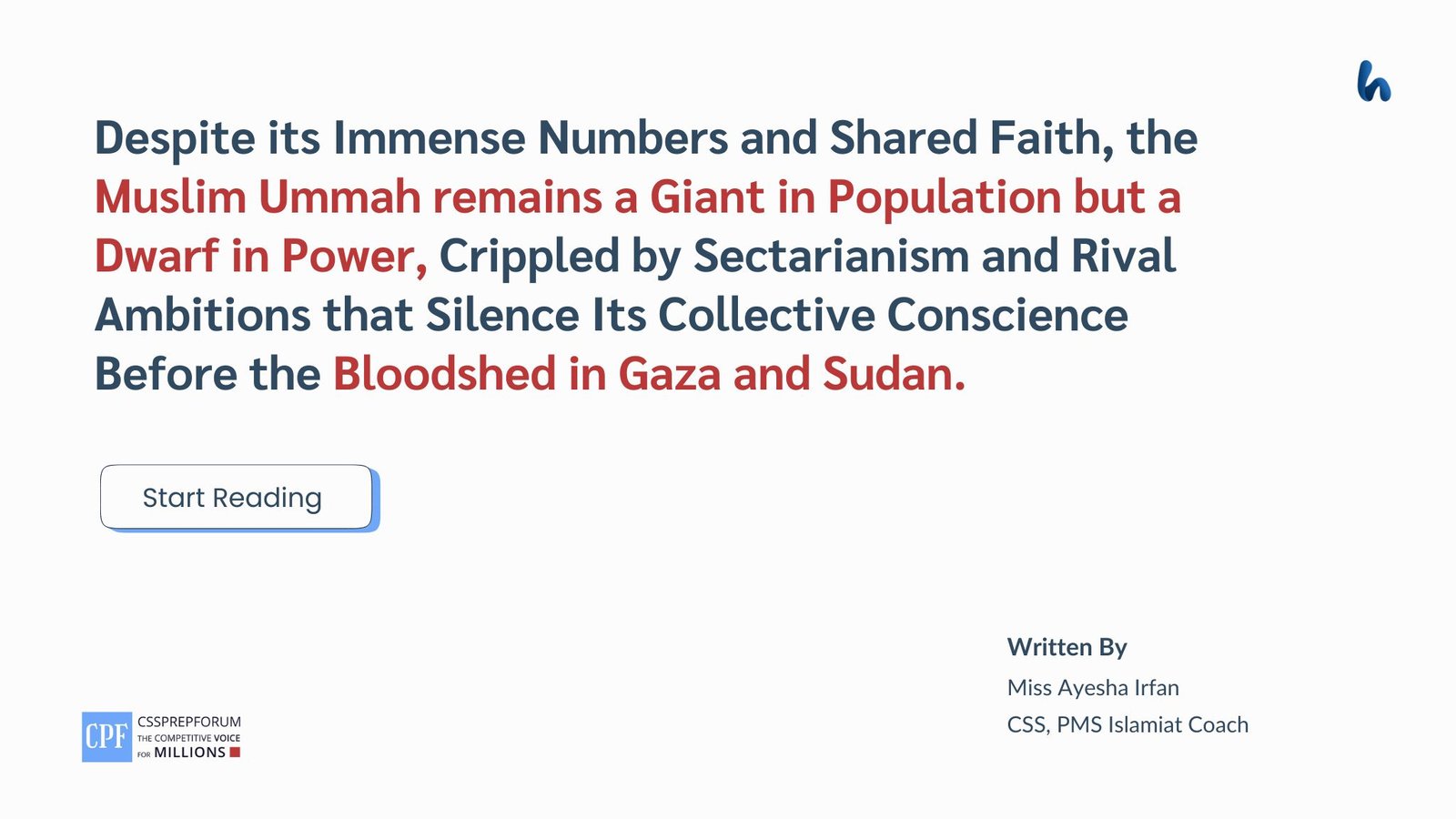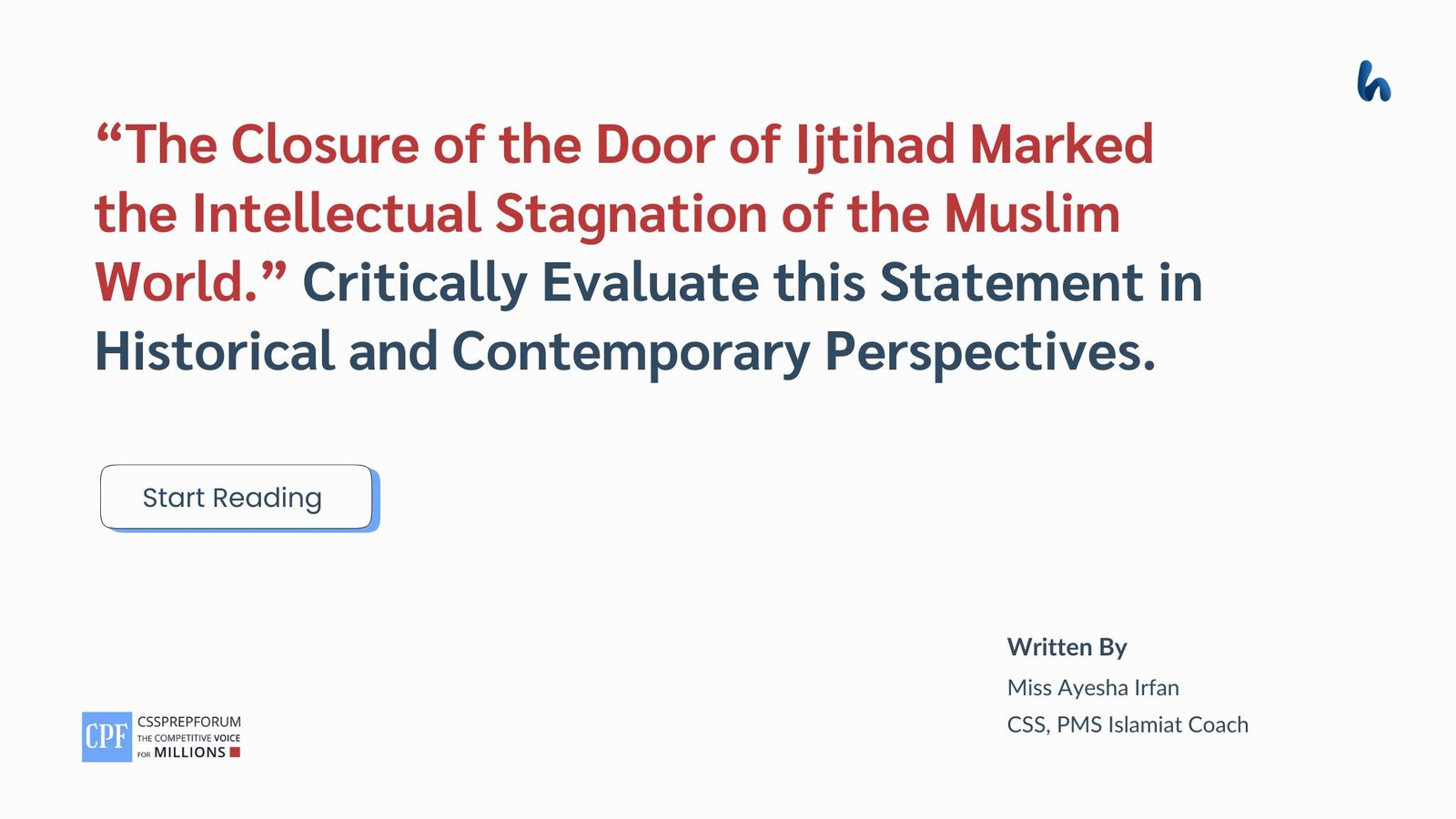CSS Current Affairs | Impacts of Israel’s Establishment on Palestinians
The following question of CSS Current Affairs is solved by Sadia Jabeen under the supervision of Howfiv’s Pakistan Affairs and Current Affairs Coaches. She learnt how to attempt 20 marks question and essay writing from Sir Syed Kazim Ali, Pakistan’s best CSS and PMS English essay and precis teacher with the highest success rate of his students. This solved past paper question is attempted on the pattern taught by Sir to his students, scoring the highest marks in compulsory and optional subjects for years, and uploaded to help aspirants understand how to crack a topic or question, how to write relevantly, what coherence is, and how to include and connect ideas, opinions, and suggestions to score the maximum.

Outline
1- Introduction
2- Historical background
3- Impact of the State of Israel on the Indigenous Palestinian population, leading to the displacement and the creation of a refugee crisis
- ✓Direct expulsion orders
- ✓Killing of Palestinians in massacres
- ✓Destruction of Arab properties
- ✓Biological and psychological warfare
- ✓Demoralizing impact of wealthier classes fleeing
4- Challenges leading to the refugee crisis of the Palestinians
- ✓Stateless status
- ✓Lack of protection
- ✓Prevention from retuning their homes
5- Response of the international community to the Palestinian refugees’ crisis
- ✓Framing legalized bodies
- ✓Political Support
- ✓Financial Aid
- ✓UN Resolution for the right to return
6- Conclusion

Answer to the Question
Introduction
The establishment of the state of Israel on May 15, 1948, led to a broke out of the war between Arabs and Zionist military forces, which ended after the occupation of Zionists over about 80% of Palestinian land, leading to the displacement of hundreds of thousands of Palestinians from their lands. The Zionist militia adopted tactic strategies by making pathetic conditions for Palestinians that they either were evacuated forcefully or fled for fear of violence by the military forces. The displacement of the local Palestinian population and the establishment of refugee camps led to a wide range of political, social and economic challenges. On the poor living conditions of Palestinian refugees, the International community responded actively by giving humanitarian aid, legal frameworks, and political efforts; however, unfortunately, the Palestinian refugee crisis could not be resolved, and they are still living in pathetic conditions.
Historical background of the establishment of the State of Israel
With the collapse of the Ottoman Empire after World War I, Britain took over Palestine and issued the Balfour Declaration in 1917 to establish a Jewish homeland in Palestine, but due to Arab opposition, the declaration remained unsuccessful and British rule was maintained over the whole of Palestine from the 1920s to 1930s. However, as a result of the Holocaust in Germany, a great number of Jews illegally entered Palestine during World War II and started terrorism against the British for betraying the Zionist cause. After the end of World War II, in 1945, the US took up the Zionist cause. Because the British were unable to find any practical solution, they referred the issue to the United Nations, which gave the idea of the partition of Palestine in November 1947. According to the United Nations Plan for Partition, about 55% of land was allocated to the Jewish state and 45% to the Palestinian state. The Jews accepted the plan, but the Arabs refused this partition to get the whole land with no Jewish state. For the sake of getting the whole Palestinian land, the Palestinian Arabs, with the help of other Arab countries’ volunteers, fought against the Zionist forces, but on May 14, 1948, the Jews took over Palestine. On the same day, the Chairman of the Jewish Agency, David Ben-Gurion, proclaimed the state of Israel in Tel Aviv.
Impact of the State of Israel on the Indigenous Palestinian population, leading to the displacement and the creation of a refugee crisis
The violent establishment of the Jewish state of Israel on May 14, 1948, had a lasting and profound impact on the indigenous Muslim population, leading to the displacement of thousands of Palestinians from their original homes, villages and neighbourhoods, creating a long-standing refugee crisis. This tragic event of displacement of Indigenous Palestinians is known as the Nakba or “catastrophe” in Arabic for the ethnic cleansing of Palestine. Zionists captured more than 78% of historical Palestine land and, divided the remaining 22% of the land into the West Bank and besieged the Gaza Strip.
Zionist army expelled a large number of Palestinians from their homes and lands either by forcing them or by fearing them. According to reports, prior to the 1948 war, the Arab Palestinian population was about 1,400,000, out of which approximately 520,000 to 1,000,000 were displaced. About 276,000 people moved to the West Bank, about 190,000 went to the Gaza Strip, and more than one-fifth people left Palestine altogether.
According to the 1949 United Nations Conciliation Commission for Palestine report, about 711,000 Palestinians lived outside Israel, while approximately one-quarter of the estimated 160,000 Palestinians remained inside Israel with the status of “internal refugees”.
Israeli military forces adopted tactic strategies by making pathetic conditions for Palestinians that they either were evacuated forcefully or fled for fear of violence by the military forces.Major factors that caused the exclusion of Indigenous Palestinians are given below.
- ✓Direct expulsion orders:
After the occupation of Palestine, Israeli authorities gave orders either to evacuate or to live under Jewish control as second-grade citizens. So because of objection to living under Jewish control, many Palestinians left their homes and went to refugee camps.
- ✓Killing of Palestinians in Massacres:
Dozens of massacres targeting Arabs were conducted by Israeli military force, killing about 15,000 Palestinians. According to historians, Zionist forces committed one of the deadliest massacres of the war in Deir Yassin Village on the western outskirts of Jerusalem. more than 1,100 children, women, and men were killed by members of the Zionist militants on April 9, 1948.
- ✓Destruction of Arab properties:
Israeli forces destroyed the local property of Palestinians, forcing them to live in refugee camps. According to reports of historians, between 400- 600 Palestinian villages and Arab localities in the coastal areas, especially Haifa and Jaffa, were totally destructed by the Zionist militia.
- ✓Biological and psychological warfare:
Israeli forces also began engaging in biological warfare in the month of April by poisoning the water of many villages, including a successful notorious operation that caused a typhoid epidemic in the area. Moreover, Zionist militias also spread the fear of recurring retaliations and the massacre of Deir Yassin among Palestinians, which psychologically depressed the indigenous Palestinians and led them to flee from fear.
- ✓Demoralizing impact of wealthier classes fleeing:
Rich merchants and other leading urban people from Tel Aviv, Jaffa, Haifa, and Jerusalem moved to Egypt, Lebanon, and Jordan. Whereas, the middle class tended to flee to Arab towns, such as Nazareth and Nablus. After that, the poor fellahin were forced to settle in the refugee camps.
Challenges leading to the refugee crisis of the Palestinians
The displacement of the local Palestinian population and the establishment of refugee camps led to a wide range of political, social and economic challenges, including:
- ✓Stateless status:
Palestinian people became stateless, with no recognized citizenship or nationality, making it harder for them to access basic facilities and rights. According to the Badil Resource Center for Palestinian Residency and Refugee Rights (Badil) and the UNRWA, about one-third of displaced Palestinians lived in refugee camps in the West Bank, Gaza, Syria, Lebanon, and Jordan with the assistance of UNRWA. Whereas the remaining refugees lived in exile as part of their societies in other countries, the majority of them did not have citizenship of any state in the world.
- ✓Lack of protection:
The Palestinians lacked national and international protection. The Palestinians who took refuge inside Israel were lacking national protection. According to Jeff Handmaker, a historical researcher, refugee camps had been targeted by the Israeli forces through documented cases of collective punishments, which punished families and even the whole refugee communities for the act of armed resistance groups of Palestine. Those who were living in refugee camps outside Israel also lacked international protection because most of the refugees were excluded from the mandate of the United Nations High Commissioner for Refugees (UNHCR) and the international legal regime to protect refugees through the definitional limitation. Nonetheless, the Relief and Works Agency (UNRWA) provided humanitarian assistance to the Palestinians, but it was without any legal protection mandate, which resulted in a legal “protection gap” for the refugees.
- ✓Prevention from returning their homes:
The Palestinians taking refuge in camps during the war were unable to return to their homes. As per the research of Jeff Handmaker, about 335,204 Palestinians with citizenship in Israel have been unable to return to their homes since 1948 after being forceful excluded because, unlike other refugee situations in the world, the Right of Return (ROR) for the Palestinian refugees was not acknowledged by the courts of Israel.
Reponse of the international community to the Palestinian refugees’ crisis
On the pathetic living conditions of Palestinian refugees after the 1948 war, the International community responded actively, giving humanitarian aid, legal frameworks, and political efforts. Some of them are given below
- ✓Framing legalized bodies:
The United Nations established the United Nations Relief and Works Agency for Palestine Refugees in the Near East (UNRWA) to provide relief and work programs for the refugees. Along with UNRWA, The United Nations High Commissioner for Refugees (UNHCR) also provided humanitarian aid and assistance to the refugees.
- ✓Political Support:
Different organizations and countries provided political support to the cause of the Palestinian refugee crisis, passing resolutions for Palestinians’ status and rights.
- ✓Financial Aid:
Various international donors, including governments and NGOs, contributed financial aid to support and improve the living conditions of Palestinian refugees.
- ✓Resolution for the right to return:
The UN passed the resolution for the right of Palestinian refugees to go back to their homes and properties, yet no serious effort had been made on the part of the UN membership to ensure the implementation of these UN Resolutions for the protection the Palestinian right of return.
Despite all these efforts, the Palestinian refugee crisis could not be solved, and they are still living in pathetic conditions.
Conclusion
The Palestinian refugee crises that were created after the forced exclusion of the indigenous population posed profound and long-lasting impacts not only on the refugees but on the whole region and is still unresolved. The descendants of the original refugees are still regarded as refugees under the mandate of UNRWA, and their total number has reached millions. Even after many years, they are stateless, living in unstable socio-economic conditions; therefore, this frustration has been the cause of recurring confrontations between the Palestinian militant groups and the Israeli military forces since 1948.

CSS Solved Past Papers’ Essays
Looking for the last ten years of CSS and PMS Solved Essays and want to know how Sir Kazim’s students write and score the highest marks in the essays’ papers? Then, click on the CSS Solved Essays to start reading them.
CSS Solved Essays
CSS Solved General Science & Ability Past Papers
Want to read the last ten years’ General Science & Ability Solved Past Papers to learn how to attempt them and to score high? Let’s click on the link below to read them all freely. All past papers have been solved by Pakistan’s top CSS GSA coach having the highest score of their students.
General Science & Ability Solved Past Papers












